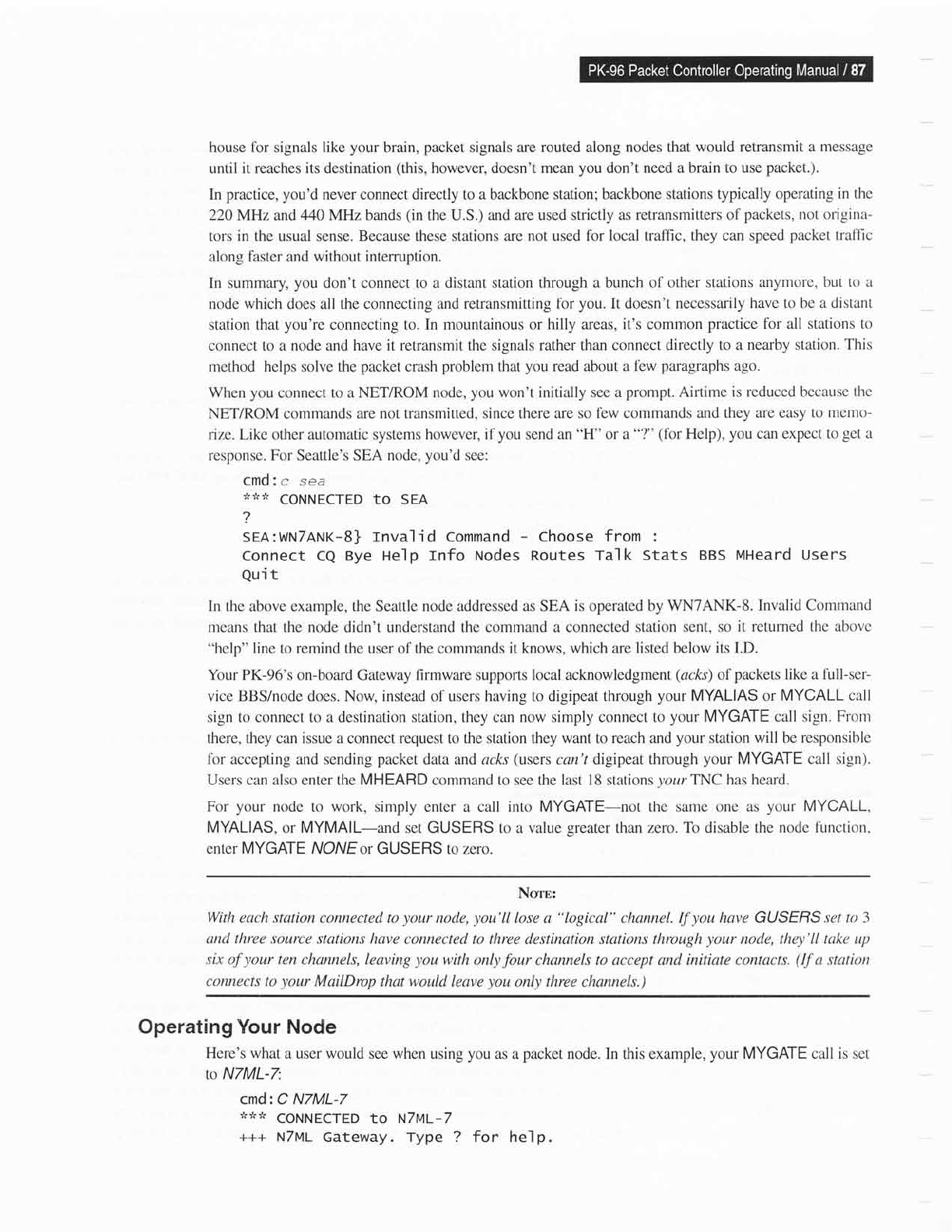Specifications
Table Of Contents

house for signals like
your
brain,
packet
signals are
routed along nodes that would
retransmit a message
until it reaches its destination
(this,
however, doesn't
mean
you
don't
need a brain to use
packet.).
In
practice, you'd
never connect directly to a backbone
station, backbone stations typically
operating
in
the
220 MHz and 440 MHz bands
(in
the U.S.) and are used strictly
as retransmitters of
packets, not
origina-
tors
in
the usual sense. Because these stations are
not used for local traffic, they
can speed
packet
traltic
along faster and without intemrption.
In summary,
you
don't connect to a distant station through
a bunch of other stations
anymore,
br,rt to a
node which
does all the
connecting and retransmitting
for
you.
It doesn't necessarily
have to be
a
distant
station that
you're
connecting to.
In mountainous
or
hilly areas,
it's
common
practice
for
all stations to
connect [o a node and
have it retransmit the signals rather than
connect directly to a
nearby station.
This
method
helps
solve the
packet
crash
problem
that
you
read about
a f'ew
paragraphs
ago.
When
you
connect to a NET/ROM
node,
you
won't initially see a
prompt.
Airtime
is
reduced
bccar.rse
the
NET/ROM commands are not transmitted, since there
are so few commands
and they are easy
to memo-
rize. Like other automatic systems however,
if
you
send
an
"H"
or a
"?"
(fbr
Help),
you
can expect
to
get
a
response. For Seattle's SEA
node,
you'd
see:
cmd:
c sea
'.'.J.
CONNECTED to SEA
?
sEA:wNTANK-8]
rnvalid
command
-
choose
from :
connect
ce
Bye Help rnfo
Nodes Routes ralk stats
BBS
MHeard users
eu'i
t
In
the above example, the Seattle
node addressed as SEA is operated by
WNTANK-8. Invalid
Command
means
that the
node
didn't understand the command
a connected station sent, so
it returned the
abovc
"help"
line to remind the user of the commands
it knows, which are listed below
its I.D.
Your PK-96's
on-board Gateway
firmware
supports
local acknowledgment
(acks)
of
packets
like a full-ser-
vice BBS/node does. Now, instead of users having to digipeat through
your
MYALIAS or
MYCALL call
sign to connect to a destination station, they can now simply connect to
your
MYGATE call
sign. Frorn
there, they can issue a connect request to the station they want to reach and
your
station
will be
responsible
for accepting
and sending
packet
data and ccks
(users
can't dtgipeat
through
your
MYGATE
call sign).
Users can also enter the MHEARD command
to see the
last l8 stations
yoar
TNC has
heard.
For your
node to work, simply enter a call into MYGATE-not the same one
as your MYCALL,
MYALIAS,
or
MYMAIL-and
set GUSERS to a value
greater
than
zero. To
disable
the node
function.
enter MYGATE NONEoT
GUSERS to zero.
NcnB:
With
each station
connected to
your
node,
you'll
lose a
"logical"
channel.
If
you
have GUSERS set to 3
and three
source stations have
connected to three destination stations through
your
node, they'll tcLke up
six of
your
ten channels, leaving
you
with
only
four
channels to accept and initiate contacts.
(lf
a
station
connects to
your
MailDrop
that
would
leave
you
only three channels.)
Operating Your
Node
Here's what
a user would see when
using
you
as a
packet
node. In
this example,
your
MYGATE call is set
to NTML-7:
cmd: C NTML-7
''JrJr
CONNECTED to
+++
NTML
Gateway.
NTML-7
Type ? for he1p.










